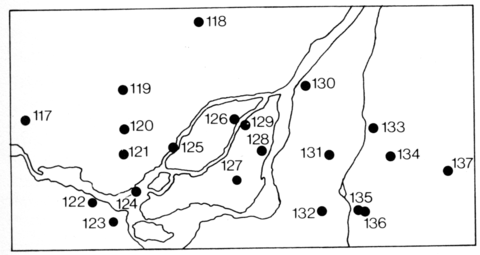stripes
Mont St Hilaire is a steep-sided hill rising to 350 m and surrounded by nearly horizontal calcareous shales, siltstones and limestones of the Ordovician Lorraine and Richmond groups. Near the intrusion the country rocks dip inwards at up to 50°, and an aureole extends for up to 150 m from the contact. The metamorphism has produced hornfelses on which at one locality metasomatism is superimposed, involving addition of Mn, Na and Ti which has resulted in the formation of narsarsukite, neptunite, arfvedsonite etc. Currie (1983) divides the igneous complex into three suites. The oldest, the Sunrise suite, comprises essentialy laminated ultramafic to gabbroic rocks varying from jacupirangites of titanaugite and magnetite through gabbros with titanaugite and kaersutite to kaersutite gabbros free of pyroxene; some anorthosites are present. The foliation is variably inward dipping and dykes of this suite cut the hornfelses. The gabbros are described in detail by Greenwood and Edgar (1984). The mesocratic Pain de Sucre suite locally cuts Sunrise suite rocks and forms a partial ring dyke on the west of the complex. The suite consists of mesocratic gabbros of plagioclase zoned outwards to alkali feldspar and with biotite as plentiful as pyroxene; a little olivine is found but amphibole is only accessory. The major part of the Pain de Sucre suite consists of rocks referred to as essexite and rouvillite in the older literature, and containing significant nepheline and olivine. Feldspar usually consists of plagioclase passing into K-feldspar and perthite rims; nepheline, usually altered to cancrinite, is interstitial and there is accessory sodalite. Mafic minerals include olivine and titanaugite partly replaced by kaersutite and biotite. The youngest East Hill suite cuts the older two and consists of various types of breccia and leucocratic nepheline and sodalite-rich syenites, pegmatites and phonolites. The breccias comprise fragments of igneous rocks, principally of the Sunrise suite, as well as some of sedimentary origin; the matrix, when distinguishable, appears to be phonolitic. The coarser syenites of the East Hill suite include rocks which have variously been described as mariupolite, litchfieldite, foyaite, pulaskite, ditroite, lujavrite, and laurdalite, involving varying combinations of alkali feldspar, euhedral nepheline and sodalite, aegirine, biotite and a wide range of accessory minerals including eudialyte, catapleite, lavenite and astrophyllite. Phonolite (tinguaite) dykes with large phenocrysts, or xenocrysts, of alkali feldspar, sodalite and nepheline occur both within the hornfels collar and as a radiating swarm cutting the Sunrise suite. A number of new and rare minerals has been described from the complex and many fine mineral specimens have come from the De-Mix quarry on the northeast flank of the mountain; Chao et al. (1967) list 87 identified and 10 unidentified species. Currie et al. (in press) give a detailed petrographic account including compositions of pyroxenes, amphiboles, biotite, ilmenite and magnetite; rock analyses and some Rb and Sr isotope data are presented, and the origin of the complex is discussed at length.
CHAO, G.Y., HARRIS, D.C., HOUNSLOW, A.W., MANDARINO, J.A. and PERRAULT, G. 1967. Minerals from the nepheline syenite, Mount St. Hilaire, Quebec. Canadian Mineralogist, 9: 109-23.
CURRIE, K.L. 1983. An interim report on the geology and petrology of the Mount Saint Hilaire pluton, Quebec. Paper, Geological Survey of Canada, 83-1B: 39-46.
CURRIE, K.L., EBY, G.N. and GITTINS, J. (in press). The petrology of the Mount Saint Hilaire complex, southern Quebec: an alkaline gabbro-peralkaline syenite association. Lithos.
GREENWOOD, R.C. and EDGAR, A.D. 1984. Petrogenesis of the gabbros from Mt. St. Hilaire, Quebec, Canada. Geological Journal, 19: 353-76.
GREENWOOD, R.C. and EDGAR, A.D. 1984. Petrogenesis of the gabbros from Mt. St. Hilaire, Quebec, Canada. Geological Journal, 19: 353-76.


